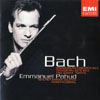Bach Brandenburg Concerto No.5; Orchestral Suite No.2 etc
Stylish performances – perhaps too polished for some – which draw on both period and modern performance practice
View record and artist detailsRecord and Artist Details
Composer or Director: Johann Sebastian Bach
Label: EMI
Magazine Review Date: 3/2001
Media Format: CD or Download
Media Runtime: 59
Mastering:
DDD
Catalogue Number: 557111-2

Tracks:
| Composition | Artist Credit |
|---|---|
| (6) Brandenburg Concertos, Movement: No. 5 in D, BWV1050 (hpd, vn, fl & stgs: 1720-21) |
Johann Sebastian Bach, Composer
Berlin Baroque Soloists Emmanuel Pahud, Flute Johann Sebastian Bach, Composer Rainer Kussmaul, Violin |
| (4) Orchestral Suites, Movement: No. 2 in B minor, BWV1067 (flute & strings) |
Johann Sebastian Bach, Composer
Berlin Baroque Soloists Emmanuel Pahud, Flute Johann Sebastian Bach, Composer Rainer Kussmaul, Violin |
| (4) Trio Sonatas, Movement: G, BWV1038 (fl, vn & cont: after Vn Son, BWV1021 pach son) |
Johann Sebastian Bach, Composer
Emmanuel Pahud, Flute Johann Sebastian Bach, Composer Rainer Kussmaul, Violin |
| Partita |
Johann Sebastian Bach, Composer
Emmanuel Pahud, Flute Johann Sebastian Bach, Composer |
Author: DuncanDruce
The lines between different sorts of performance of earlier music are becoming increasingly blurred. In a phrase that’s not entirely clear, we’re told here that the Berlin Baroque Soloists ‘use early but modernised instruments… gut strings and bows from different periods’. Emmanuel Pahud, of course, plays a modern flute, but he’s clearly been listening to players of the 18th-century one-key instrument, and found he can imitate or find a modern equivalent for many of the expressive features of the old flute. Altogether these are stylish performances, with excellent choices of tempo, awareness of the character of the dances in the Suite and the Partita, buoyant rhythms and beautiful shaping of phrases. Pahud introduces some appropriate and imaginative ornamentation (as do Kussmaul and Schornsheim in the Brandenburg No 5). In the B minor Suite there are a few places where the internal balance isn’t perfect; the amazingly eventful second-violin part in the first Bourree needs to be brought out more, so that it can rival the top flute and violin line. I also found the harpsichord in the Brandenburg just slightly distant; in the first movement especially it’s not easy to hear all the detail when other instruments are playing.
Given the choice, I think I’d always opt for finely played period instruments; the sound here has a high-gloss finish that marginally distances the impact of the music. For all that, it’s very fine Bach playing, to be wholeheartedly recommended.'
Given the choice, I think I’d always opt for finely played period instruments; the sound here has a high-gloss finish that marginally distances the impact of the music. For all that, it’s very fine Bach playing, to be wholeheartedly recommended.'
Discover the world's largest classical music catalogue with Presto Music.

Gramophone Digital Club
- Digital Edition
- Digital Archive
- Reviews Database
- Full website access
From £8.75 / month
Subscribe
Gramophone Full Club
- Print Edition
- Digital Edition
- Digital Archive
- Reviews Database
- Full website access
From £11.00 / month
Subscribe
If you are a library, university or other organisation that would be interested in an institutional subscription to Gramophone please click here for further information.




